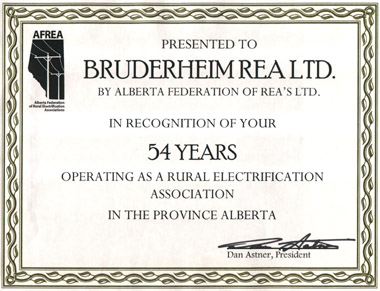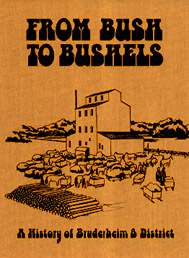
 |
History of the Bruderheim REA and of the REA movement
History
| Rapid improvements in the agricultural scene followed the invention and development of
the steam engine and the internal combustion engine. A few decades later it was the
arrival of the rubber-tired tractor and the stringing of electrical power lines to the
farms. The turning on of power in late October 1950 to the Bruderheim REA lines ushered in
an era of developments that surpassed the expectations of all people connected with its
production and consumption. When a group of interested farmers inquired into the feasibility of getting high
tension power lines out to the farmsteads, the eventual result was the formation of the Bruderheim Rural Electrification Association. Up to this point in time, a minority of
farmers had electric light plants. These would usually consist of a gas engine driven
generator and a set of wet batteries providing a direct current of 32 volts. The wind
charger was a propeller driven generator and was dependent on the wind for its motive
power. The laundry could be done on days when the wind was blowing. It was a source of
very limited power and was chiefly used as a means of lighting. It was this desire for
something better that led to the formation of the Bruderheim REA.
Enquiries and meetings with officials of Calgary Power and government convinced a group
of interested farmers that their desire for high-tension line power was practical.
On March 25,1948, a meeting was held by a group of farmers in the old
Social Credit Hall. They expressed their desire to form an Association
and therefore were duly registered under provisions of the Cooperative
Associations Act. The charter board of directors is shown below.
Members of the founding Board of Directors of
the Bruderheim REA
E. Doige,
G. A. Schultz,
August Bott,
Ed Rinas,
Elmer Strauss,
Ben Krebs,
Adolph Schneider,
Fred
Schultz, and
O. C. Degen.
The executive of the charter board was comprised of:
Adolph Schneider — (Chairman),
Fred Schultz —
(Vice-chairman),
Ben Rosnau — (Secretary-Treasurer).
|
The Bruderheim Windmill
William Mallon was Married to Julia Wagner,
 sister
of John Wagner. William was noted as the designer and
builder of the windmill which he made entirely from wood,
including the gears and the nails. There were no metal
parts. The millstones were selected from the North
Saskatchewan River, chiseled and ground down by hand. The
mill was used by the family to grind their own flour, crush grain
for the cattle and cut their own firewood. When the wind
blew at an appropriate velocity, this mill could turn out a very
acceptable rye flour [about 150lbs per day]. sister
of John Wagner. William was noted as the designer and
builder of the windmill which he made entirely from wood,
including the gears and the nails. There were no metal
parts. The millstones were selected from the North
Saskatchewan River, chiseled and ground down by hand. The
mill was used by the family to grind their own flour, crush grain
for the cattle and cut their own firewood. When the wind
blew at an appropriate velocity, this mill could turn out a very
acceptable rye flour [about 150lbs per day].
In the early 1950s, the mill was purchased and moved to Bruderheim
on a site south of the Moravian Church cemetery. Later it
was moved to Heritage Park in Calgary. It is still used on
occasion to
grind flour to sell to tourists. [Bush to Bushels,
p. 360] Today, with the flick of a switch or
 the push of a
button, and with one of
the many models of
small grain mills for household use available that weigh from
nine to about 50 lbs and are driven by electric motors that
consume from 300Wh to 1.25kWh, a comparable and even far
larger output of flour can be achieved with far less effort and
far less investment in time, attention and money. An example
of such a mill is shown in the photo at right. the push of a
button, and with one of
the many models of
small grain mills for household use available that weigh from
nine to about 50 lbs and are driven by electric motors that
consume from 300Wh to 1.25kWh, a comparable and even far
larger output of flour can be achieved with far less effort and
far less investment in time, attention and money. An example
of such a mill is shown in the photo at right.
Mind you, it will not likely happen, if ever, that the modern grain
mills will evoke as much interest and nostalgia as mills such as the
Bruderheim Windmill do. It appears that when it took hard work
and ingenuity by many individuals to achieve things for many, the
efforts of those individuals were and still are much more
appreciated than the output of mass-produced machines, even though
the designing of those machines and the designing and manufacturing
of the tools and machines required to produce them requires far
greater ingenuity and skills by far greater numbers of men than did
their medieval prototypes.
Regardless of how much those machines were improved over the years,
they, their prototypes and even the electricity used to drive them
now were originally and are still now successfully used to make life
for women easier.
That is one of the reasons why women appreciate men and are
grateful to them, men such as the founders of the Bruderheim REA
whose hard work brought electric services to the rural area around
Bruderheim. |
The work of canvassing the area farmers for membership now started in earnest,
 so that
plans for construction could be drawn up. Easements for right-of-way had to be obtained.
Brushing crews had to do clearing so that the survey scheduled for November 15, 1949 could
get underway. so that
plans for construction could be drawn up. Easements for right-of-way had to be obtained.
Brushing crews had to do clearing so that the survey scheduled for November 15, 1949 could
get underway.
This was a new adventure not only for the farmers but equally so for Calgary Power which
was to be the supplier of electricity. No one had any experience which would have provided
some guidance for a project that was truly a pioneering venture. The farmers did as much
of the actual construction work as possible in order to save costs.
With an estimated cost of $830 per member, 64 contracts were signed. That was based on
an average of 5/8 mile of line required per member. Extra footage would be charged for
members living beyond this distance. Loans from chartered banks were available for farmers
who could not afford the total cost immediately. These required a $200 down payment with
the balance payable over a 5-year period at 3 1/2% interest.
Mr. Oberholtzer, the Deputy Minister for the Department of Trade and Industry assured
the Association that the government would underwrite 1/3 of the total cost.
Some farmers would not sign easements and the matter had to be referred to the M.D. of
Lamont.
In May 1950, a master contract was signed with Farm Electric Services. This was a
subsidiary company set up by Calgary Power to administer and service rural association
consumers. In June, construction commenced with Ken Goodwin, the project engineer in
charge. Calgary Power brought in their digger which was used to dig holes. The farmers
themselves supplied labour crews for aligning of poles, tamping, installing pole
insulators, brushing, mending of fences and whatever other work was required.
The Association had set their rate of pay at $1 per hour. Mr. Anderson of Farm Electric
Services informed the board that that rate of pay was too high since their rate was only
75¢ per hour at the time. The board nevertheless remained with their rate.
In just a few summer months, the construction of the lines was completed. Farm
Electric's crew strung the wires and set the transformers. There was also a flurry of
activity to get farm homes and barns wired, in readiness for the day when electricity
would flow through the lines.
To celebrate the turning on of power, a banquet for members and their wives was
discussed. However, there was no facility available that could accommodate such a large
number of people. Therefore, the idea had to be discarded.
In August 1952, after two years of operation the membership realized a $110 refund on
their original construction contract.
The advent of electrical power on the farm brought about an entirely new way of life to
the old homestead. Electricity is used in ever more labour-saving applications.
The original desire for electrical power never diminished over the years. It
steadily
increased to the point where we are now completely dependent on its uninterrupted flow.
The system now serves over 440 farms, acreages and commercial outlets. (Bush to Bushels, p. 213)

FROM BUSH TO BUSHELS
A History of Bruderheim & District,
© Bruderheim Historical Committee
(Friesen Printers, Edmonton, Alberta, Canada, ISBN 088925-340-4, 1983)
Next:
Early History of the Tennessee Valley Authority
—
Lessons for today
More on the history of rural
Alberta (incl. photos of fall colours of the fall the year 2000)
__________________
Posted 2002 03 23
Updates:
2002 04 13 (added copy of recognition certificate)
2004 01 16 (added separate page for, and link to the history of the TVA)
2005 10 13 (added story of the Bruderheim windmill)
|



